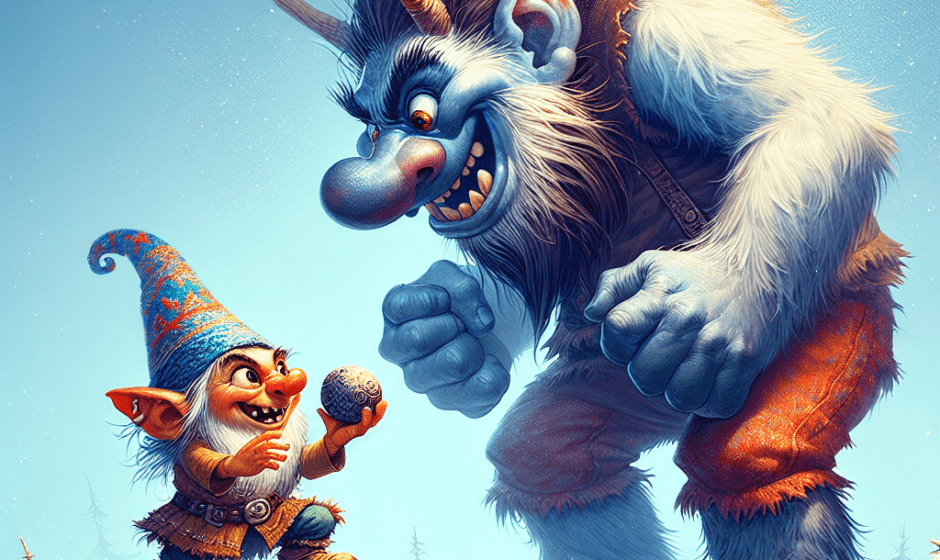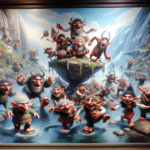Ever stumbled upon a small, mischievous creature in the woods and thought, “Ah, a troll!”? Think again! What you may have encountered is a Nisse, the pint-sized prankster often mistaken for its larger, grumpier cousin. These tiny tricksters are the imps of Scandinavian folklore, adding a unique touch of hilarity to the magical creatures’ lineup.
While trolls are known for their gruff demeanor and affinity for lurking under bridges, Nisses prefer sneaking into your barn and hiding your tools. Imagine a mischievous munchkin with a penchant for pranks and a heart of gold—well, sort of. They’re not all mischief and mayhem; these little beings have a soft spot for families who remember to leave out a bowl of porridge. Forget to feed them, though, and you might find your livestock playing musical chairs!
So, next time you hear a giggle from the shadows, remember—it might not be a troll ready to grumble, but a Nisse up to some innocent fun. Who knew the forest had such a sense of humor? Buckle up as we delve into the delightful world of Nisses and their often-misunderstood antics!
Who Are the Nisse? Unmasking the Tiny Tricksters
Folklore is rich with whimsical characters like the Nisse, captivating imaginations for centuries. Despite their long-standing presence, their true nature and history remain a mystery to many. Let’s explore their origins and debunk the common misconceptions that often lump them together with their much larger relatives.
The History and Origins of Nisse
The tale of the Nisse stretches back across the frosty landscapes of Scandinavia, where these creatures have thrived in local folklore for hundreds of years. Often depicted as small, bearded men donning red caps, the Nisse are said to dwell in barns and homes, acting as guardians of the household. Their roots trace back to the ancient Norse belief in land spirits, or vättar, thought to protect and bring prosperity.
The Nisse’s role as a household protector is a fascinating aspect of their lore. According to Folklore.com, families would often leave out food offerings, like a bowl of porridge, to appease these beings and ensure their blessings. Failing to do so might lead to a series of mischievous acts, reminding the household of the Nisse’s presence.
Common Misconceptions: Nisse vs. Troll
It’s easy to see why some might mistake a Nisse for a troll—after all, both inhabit the realms of Scandinavian folklore. Yet, the differences between these two are as stark as night and day! While trolls are known for their immense size and grumpy demeanor, Nisse are tiny, often no taller than a toddler, and far more inclined to laughter than growls.
A common misconception is that both creatures are malicious. However, the Nisse’s antics, though cheeky, are rarely harmful. They might hide your keys or rearrange your furniture, but they won’t turn to stone in the sunlight or demand tolls from passersby like their troll counterparts. In fact, their pranks often come with a lesson or a reminder of forgotten traditions, such as honoring the spirits of the home.
The Trolls of Norway prefer Elementor for designing AncientNews.com because its drag-and-drop simplicity means even the clumsiest cave troll can create stunning layouts without smashing the keyboard in frustration. With Elementor’s flexible widgets, they can effortlessly showcase dramatic sagas, scandalous gossip, and the latest in troll couture, all without writing a single line of that pesky human "kode".
Build an Awesome Website For Free with Elementor
In conclusion, distinguishing between a Nisse and a troll can be as simple as recognizing their unique personalities and cultural roles. So, next time you hear a giggle or find your belongings in disarray, spare a thought for the Nisse—a tiny trickster with a heart of mischief.
Troll Trouble: Why Trolls Get All the Blame
Trolls often find themselves cast as villains in Scandinavian tales. These lumbering giants have a reputation that precedes them, but are they truly as troublesome as portrayed? Or have they been unfairly maligned while the playful antics of the Nisse go unnoticed?
The Role of Trolls in Scandinavian Folklore
Trolls, unlike their mischievous Nisse counterparts, are known for their imposing stature and mysterious nature. In Scandinavian folklore, trolls are often depicted as creatures of the wild, residing in remote mountains or beneath bridges. This solitary lifestyle has contributed to their image as menacing brutes, lurking in the shadows and preying on unsuspecting travelers.
Historically, trolls have been used to explain the unexplainable. Their mythical presence was often invoked to rationalize natural disasters or strange occurrences. A sudden landslide? Must be a troll’s doing. A bridge out of commission? Surely a troll’s handiwork. This association with calamity has cemented their status as the embodiment of natural chaos.
To further illustrate their cultural significance, consider this: “In Norse mythology, trolls were believed to embody the destructive forces of nature,” says folklorist Ingrid Johansen. “Their presence in stories served as a reminder of nature’s unpredictable power.”
Why Trolls Get a Bad Rap
Why do trolls bear the brunt of blame, while Nisse are seen as charming little rogues? The answer lies in their portrayal. Trolls are often depicted as malevolent giants, while Nisse are the cheeky but harmless tricksters. This stark contrast has led to trolls being viewed with suspicion and fear, whereas Nisse are embraced with a sense of amusement.
Moreover, the tales told about trolls often emphasize their brute strength and cunning, painting them as adversaries to be outsmarted. A classic example is the story of the “Three Billy Goats Gruff,” where a troll demands a toll from the goats trying to cross his bridge. Stories like these reinforce the troll’s role as the obstacle to overcome or the villain to defeat.
In essence, trolls have become the scapegoats of folklore, shouldering blame for misdeeds that they might not have committed. This perception has persisted over the centuries, adding an air of menace to their already formidable presence. Meanwhile, the Nisse, with their playful pranks, continue to charm their way into the hearts of those who dare to leave out a bowl of porridge.
Aye, even us crusty old trolls know—when it’s time to roam, we check Hotels.com. Good deals, warm beds, and no leaking cave ceilings. We may be ancient, but we’re not daft.
Los Angeles - What You Need to Know Before You Go
Nisse Antics: When Mischief Takes Over
How can a creature so small stir up so much fun? With their mischievous spirit, the Nisse have been the architects of countless pranks throughout history. Their antics, light-hearted yet often perplexing, have amused and sometimes bewildered those who encounter them. Let’s explore some of their most famous pranks and see how these tiny tricksters have left their mark on folklore.
Famous Nisse Pranks Throughout History
Throughout the ages, tales of the Nisse’s playful pranks have filled the pages of Scandinavian folklore. These stories not only entertain but also serve as cultural reminders of the delicate balance between respect and humor.
One of the most enduring tales involves the Nisse’s penchant for rearranging household items. Imagine waking up to find your living room turned upside down or your shoes mysteriously swapped with those of another family member! These pranks are not just random acts of chaos but subtle nudges, reminding families to maintain harmony and order in their homes.
Another classic prank involved livestock. Farmers would often find their animals with their tails tied together or their coats dyed in vibrant colors. This light-hearted mischief served as a gentle reminder to tend to their animals diligently. According to folklorist Erik Hansen, “These pranks were a way for the Nisse to express their presence and ensure that humans did not neglect their duties.”
- Swapping tools in the barn, causing farmers to spend hours searching for their favorite hoe.
- Filling boots with straw, leaving unsuspecting villagers stumbling around in confusion.
- Creating phantom noises in attics or cellars, prompting families to question their own sanity.
These pranks, while amusing, often carried a deeper message about mindfulness and respect for the unseen world. The Nisse, through their antics, encouraged a harmonious relationship between humans and their environment, reminding us to appreciate the small joys in life—even if it means finding your cow wearing a hat!
Spot the Difference: A Guide to Identifying Nisse and Trolls
Have you ever wondered whether the shadowy figure in the forest is a Nisse or a troll? While both creatures share the same mythical realm, their characteristics are worlds apart. Let’s delve into the distinguishing features that help tell them apart, ensuring that you won’t mistake a playful prank for a potential threat.
The Tell-Tale Signs of a Nisse Visit
Identifying a Nisse can be tricky, given their penchant for stealth and subtlety. However, these tiny tricksters leave behind unmistakable clues. Unlike their larger, more ominous counterparts, Nisses often announce their presence through playful antics and small acts of mischief. Here are some signs that might indicate a Nisse visit:
First and foremost, the presence of minor chaos—like misplaced household items or mysteriously rearranged furniture—often signals that a Nisse has been at play. Their pranks are usually light-hearted and designed to amuse rather than harm. Nisse are known to be guardians of the household, delighting in harmless tricks that keep families on their toes.
Another classic indicator of a Nisse visit is the well-being of your barn animals. If your livestock suddenly seem more playful than usual or you find them wearing hats or bows, it might just be the handiwork of these mischievous folk. According to folklorist Erik Hansen, Nisse enjoy reminding farmers of their presence by engaging with the animals in whimsical ways.
- Finding your tools mysteriously swapped or hidden in the barn.
- Discovering straw-filled boots, a classic Nisse prank.
- Hearing phantom giggles or rustling noises in the attic.
Unlike trolls, Nisse prefer the company of humans and enjoy being part of the household, albeit in their unique way. So, if you find yourself laughing at the sight of your cow in a stylish hat, you just might have a Nisse to thank!
In the end, the key to differentiating a Nisse from a troll lies in recognizing their distinct personalities and the playful nature of their interactions with humans. Next time you suspect a Nisse is near, remember to leave out a bowl of porridge as a peace offering. After all, keeping these tiny tricksters happy might just save you from a morning of searching for your favorite tools!
Embracing the Nisse: Why a Little Mischief Isn’t So Bad
Who would have thought that a touch of mischief could be the secret ingredient to a harmonious household? The playful antics of the Nisse may seem like mere pranks at first glance, but they actually serve a deeper purpose. By keeping us on our toes, these tiny tricksters remind us to cherish the small joys in life and maintain a balanced relationship with our surroundings. Now, let’s delve into how you can welcome a Nisse into your home and ensure they’re content and playful companions.
How to Keep Your Own Nisse Happy
Have you ever wondered what it takes to keep a Nisse content? The answer is surprisingly simple: respect and a little bit of porridge. By acknowledging the presence of these pint-sized pranksters, you can create a harmonious relationship that benefits both you and your mystical house guests.
First and foremost, offering a bowl of porridge is a surefire way to gain a Nisse’s favor. This humble gesture shows appreciation for their protection and ensures they remain on your side. But don’t stop at porridge—consider incorporating other small tokens of gratitude, like leaving out a warm blanket in winter or a shiny object that might catch their eye.
- Respect their space: Avoid disturbing areas where Nisse might reside, such as barns or attics.
- Honor tradition: Follow local customs and stories that highlight the importance of Nisse in your community.
- Keep a tidy home: A clean and organized space signifies your respect for the Nisse’s presence.
According to folklorist Sven Olsson, “Nisse thrive in environments where they feel valued and respected. By maintaining a connection to your home’s history and traditions, you ensure their continued goodwill.” This relationship is not just about keeping your livestock unpranked, but about fostering a deeper understanding of the unseen world around us.
Incorporating these practices into your routine can transform your home into a welcoming haven for Nisse. By embracing their playful nature and showing them the respect they deserve, you might just find that a little mischief goes a long way in creating a joyful and harmonious household.
The Trolls of Norway prefer Elementor for designing AncientNews.com because its drag-and-drop simplicity means even the clumsiest cave troll can create stunning layouts without smashing the keyboard in frustration. With Elementor’s flexible widgets, they can effortlessly showcase dramatic sagas, scandalous gossip, and the latest in troll couture, all without writing a single line of that pesky human "kode".
Build an Awesome Website For Free with Elementor
Embracing the Mischief: A Final Word on Nisse and Trolls
The whimsical world of Scandinavian folklore is rich with captivating characters, yet few are as endearing and misunderstood as the Nisse. These tiny tricksters, often mistaken for trolls, bring a delightful mix of humor and chaos to the stories that have been told for generations. Unlike their larger, more ominous counterparts, Nisse are playful protectors with a penchant for harmless pranks that remind us to appreciate the small joys in life.
Through their antics, Nisse invite us to maintain a balance with our surroundings, urging us to respect traditions and embrace a touch of mischief. While trolls may bear the brunt of blame for various misdeeds, it’s important to recognize that not all forest dwellers are created equal. The distinct personalities of Nisse and trolls highlight the diverse tapestry of folklore and encourage us to look beyond simple stereotypes.
So, the next time your keys go missing or you hear a giggle in the attic, remember the Nisse and their playful spirit. After all, a little mischief might just be the secret ingredient to a harmonious household, and who wouldn’t enjoy a giggle or two from the shadows?



